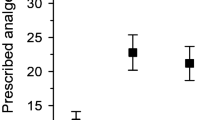Abstract
Chronic pain is one of the most common chronic conditions affecting more than 50 % of older adults. While pain management can be quite complex, prescription drugs are the most commonly used treatment modality. In this study, I examine whether increased access to prescription drugs due to the introduction of the Medicare Part D program in 2006 led to better management of pain among the elderly. While prior work has identified increases in the utilization of analgesics due to the introduction of Medicare Part D, the extent to which this increase in drug use actually improved the well-being of older adults is not known. Using data from the Health and Retirement Study, I employ a difference-in-differences strategy that compares pre versus post 2006 changes in pain related outcomes between Medicare eligible persons and a younger ineligible group. I find that Medicare Part D significantly reduced pain related activity limitations among a sample of older adults who report being troubled by pain.






Similar content being viewed by others
References
Ayyagari, P., & Shane, D. M. (2015). Does prescription drug coverage improve mental health? Evidence from Medicare Part D. Journal of Health Economics, 41, 46–58.
Baicker, K., Taubman, S. L., Allen, H. L., Bernstein, M., Gruber, J. H., Newhouse, J. P., et al. (2013). The Oregon experiment—effects of medicaid on clinical outcomes. New England Journal of Medicine, 368(18), 1713–1722.
Cameron, C., & Miller, D. (2015). A practitioner’s guide to cluster-robust inference. Journal of Human Resources, 50(2), 317–372.
Campbell, C. I., Weisner, C., LeResche, L., Ray, G. T., Saunders, K., Sullivan, M. D., et al. (2010). Age and gender trends in long-term opioid analgesic use for noncancer pain. American Journal of Public Health, 100(12), 2541–2547.
Card, D., Dobkin, C., & Maestas, N. (2009). Does medicare save lives? The Quarterly Journal of Economics, 124(2), 597–636.
Chien, S., Campbell, N., Hayden, O., Hurd, M., Main, R., Mallett, J., Martin, C., Meijer, E., Moldoff, M., & Rohwedder, S. (2014). RAND HRS data documentation, Version N.
Engelhardt, G. V., & Gruber, J. (2011). Medicare Part D and the financial protection of the elderly. American Economic Journal: Economic Policy, 3(4), 77–102.
Finkelstein, A., & McKnight, R. (2008). What did Medicare do? The initial impact of Medicare on mortality and out of pocket medical spending. Journal of Public Economics, 92(7), 1644–1668.
Finkelstein, A., Taubman, S., Wright, B., Bernstein, M., Gruber, J., Newhouse, J. P., et al. (2012). The Oregon health insurance experiment: Evidence from the first year. The Quarterly Journal of Economics, 127(3), 1057–1106.
Gaskin, D. J., & Richard, P. (2012). The economic costs of pain in the United States. The Journal of Pain, 13(8), 715–724.
Gilson, A. M., Ryan, K. M., Joranson, D. E., & Dahl, J. L. (2004). A reassessment of trends in the medical use and abuse of opioid analgesics and implications for diversion control: 1997–2002. Journal of Pain and Symptom Management, 28(2), 176–188.
Hanlon, J. T., Boudreau, R. M., Perera, S., Strotmeyer, E. S., Newman, A. B., Simonsick, E. M., et al. (2013). Racial differences in antilipemic use and lipid control in high-risk older adults: Post-Medicare Part D. American Heart Journal, 166(4), 792–797.
Joranson, D. E., Ryan, K. M., Gilson, A. M., & Dahl, J. L. (2000). Trends in medical use and abuse of opioid analgesics. JAMA, 283(13), 1710–1714.
Kaestner, R., & Khan, N. (2010). Medicare Part D and its effect on the use of prescription drugs, use of other health care services and health of the elderly, National Bureau of Economic Research
Kaestner, R., Long, C., & Alexander, G. C. (2014). Effects of prescription drug insurance on hospitalization and mortality: Evidence from Medicare Part D, National Bureau of Economic Research.
Kapteyn, A., Smith, J. P., & Van Soest, A. (2008). Dynamics of work disability and pain. Journal of Health Economics, 27(2), 496–509.
Ketcham, J., & Simon, K. (2008). Medicare Part D’s effects on elderly patients’ drug costs and utilization. The American Journal of Managed Care, 14(11 Suppl), SP14.
Levy, H., & Meltzer, D. (2008). The impact of health insurance on health. Annual Review of Public Health, 29, 399–409.
Levy, H., & Weir, D. R. (2010). Take-up of Medicare Part D: Results from the Health and Retirement Study. The Journals of Gerontology Series B: Psychological Sciences and Social Sciences, 65(4), 492–501.
Lichtenberg, F. R., & Sun, S. X. (2007). The impact of Medicare Part D on prescription drug use by the elderly. Health Affairs, 26(6), 1735–1744.
Manning, W. G., Newhouse, J. P., Duan, N., Keeler, E. B., & Leibowitz, A. (1987). Health insurance and the demand for medical care: Evidence from a randomized experiment. The American Economic Review, 77, 251–277.
Pacula, R. L., Powell, D., & Taylor, E. (2015). Does prescription drug coverage increase opioid abuse? Evidence from Medicare Part D, National Bureau of Economic Research
Patel, K. V., Guralnik, J. M., Dansie, E. J., & Turk, D. C. (2013). Prevalence and impact of pain among older adults in the United States: Findings from the 2011 National Health and Aging Trends Study. Pain, 154(12), 2649–2657.
Author information
Authors and Affiliations
Corresponding author
Rights and permissions
About this article
Cite this article
Ayyagari, P. Prescription drug coverage and chronic pain. Int J Health Econ Manag. 16, 189–200 (2016). https://doi.org/10.1007/s10754-016-9185-5
Received:
Accepted:
Published:
Issue Date:
DOI: https://doi.org/10.1007/s10754-016-9185-5




